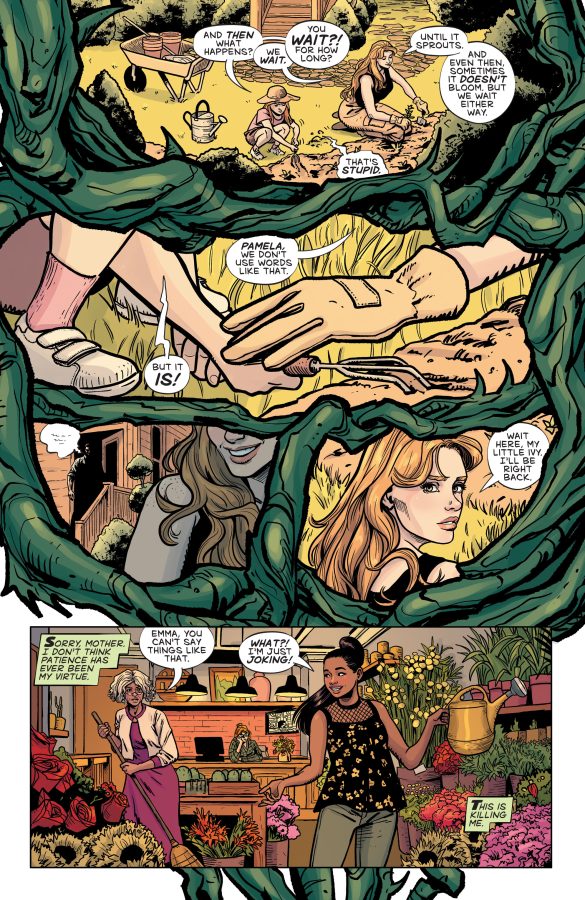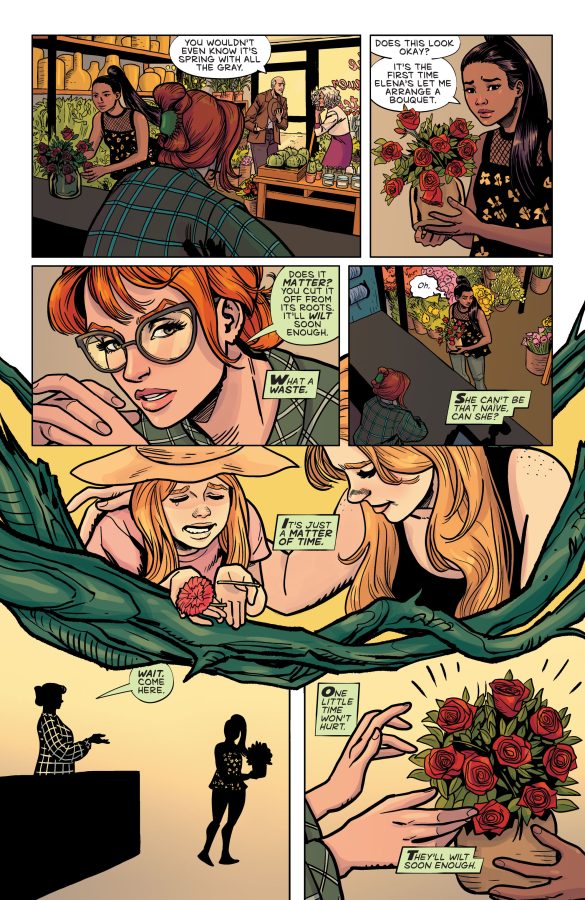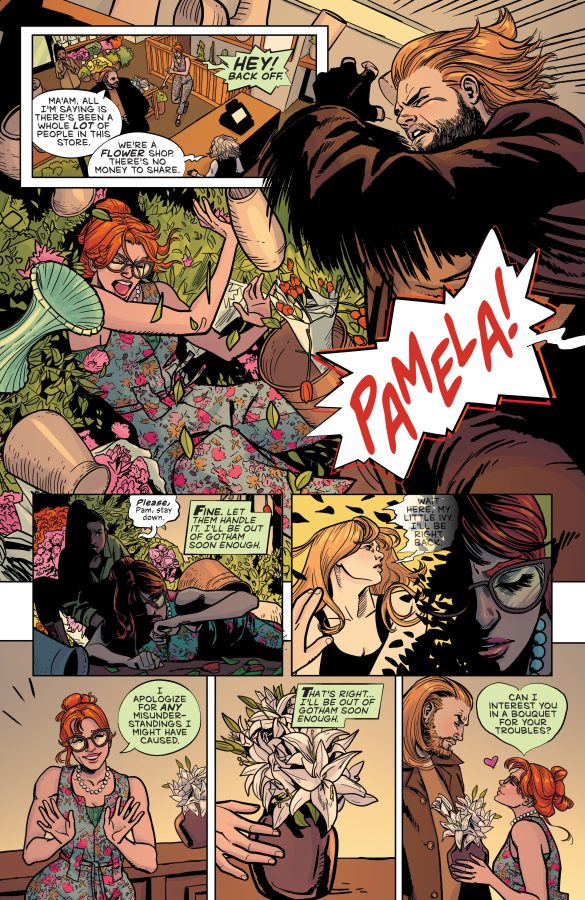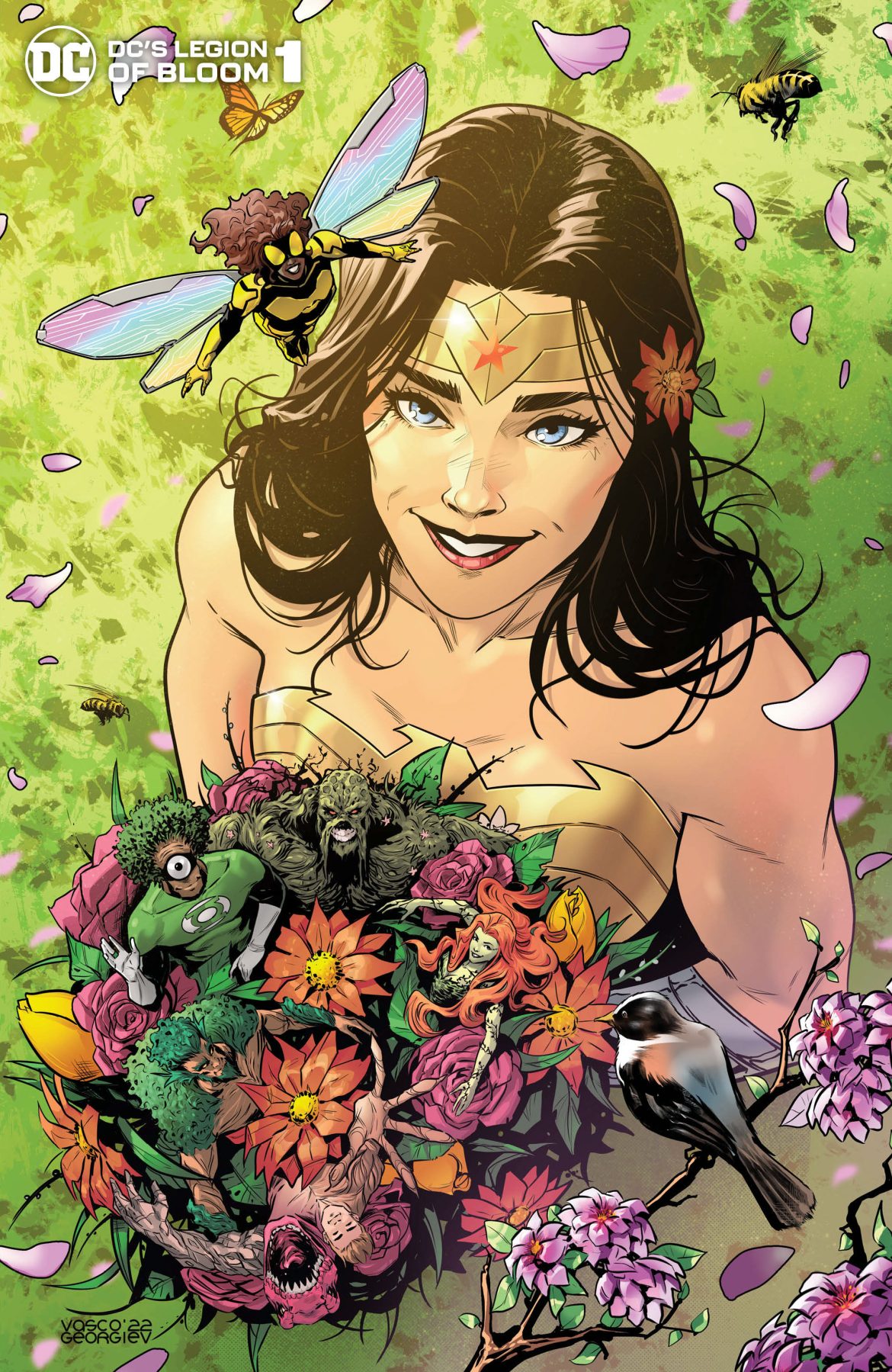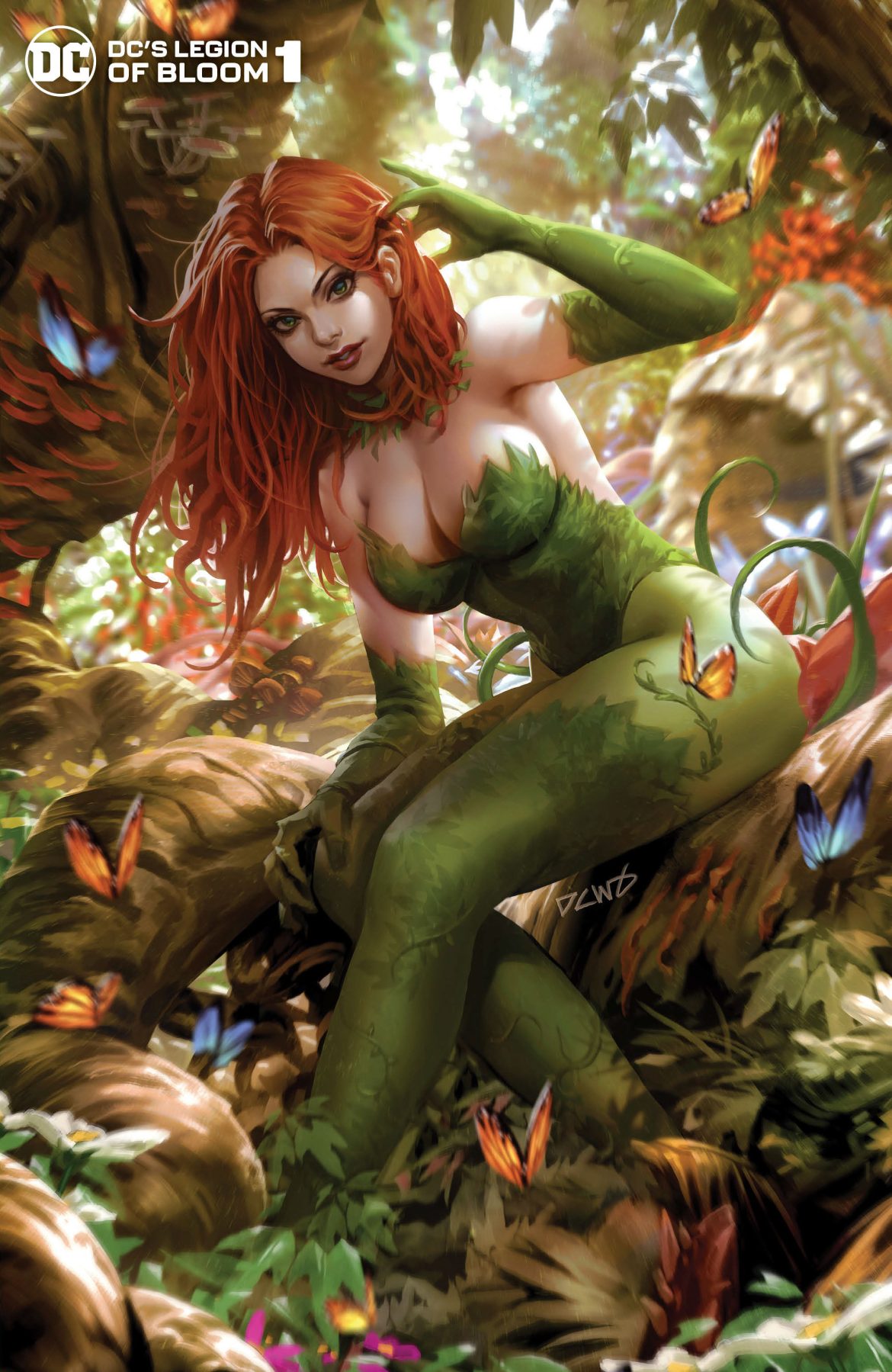“Legion of Bloom” – DC Spring Special
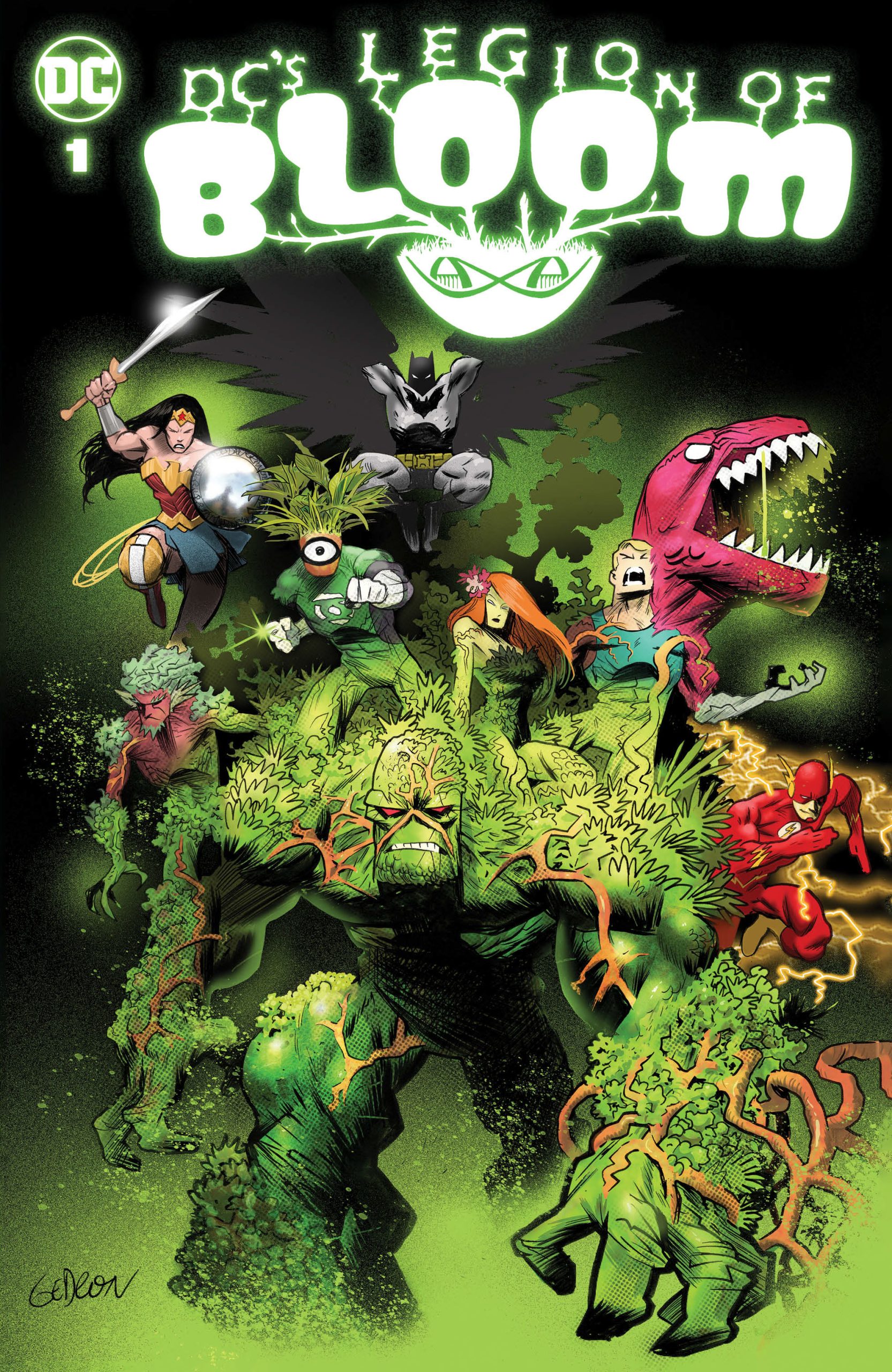 Writers: Ashley Allen, Zac Thompson, Jula Anta, Cavan Scott, Kenny Porter, Calvin Kasulke, Travis Moore, Dave Wielgosz
Writers: Ashley Allen, Zac Thompson, Jula Anta, Cavan Scott, Kenny Porter, Calvin Kasulke, Travis Moore, Dave Wielgosz
Artists: Isaac Goodhart, Hayden Sherman, Jacoby Salcedo, Atagun Ilhan, Mar Morales, Brian Level, Jay Leisten, Vitor Cafaggi, Travis Moore, RIley Rossmo
Color Artists: Cris Peter, Patricio Delpeche, Allen Passalaqua, Hi-Fi, Jordan Boyd, Vitor Cafaggi, Eren Enrica Angiolini, Ivan Plascencia
Letterers: Hassan Otsmane-Elhaou, Becca Carey, Dave Sharpe, Carlos M. Manual, Steve Wands, Tom Napolitano
Review by Derek McNeil
DC continues their wonderful tradition of seasonal anthology titles with DC’s Legion of Bloom #1. Each of the eight stories features a protagonist or situation related to the yearly season of renewal and rebirth. The list of creators contains a number of new names as well as a few familiar ones.
I have to say that I like the choice of title for this anthology. Legion of Bloom is a clever pun on the name of the supervillain group, the Legion of Doom. I would love to see an actual group of plant-themed characters like Swamp Thing, Poison Ivy, and the Floronic Man band together under that name.
DC often uses these anthologies as a testing ground for new creators, so it’s quite likely that we’ll be seeing more of these new names in future DC projects. Similarly, DC will also float concepts that may launch into future titles so, looking over some of these stories in this anthology, there are a number ideas that I’d love to see developed further.
“Growing Pains”
The first story features Poison Ivy’s struggle to fit in among “normal” people. She does well at first, working under a false name at a florist. However, things go awry when gangsters arrive to shake down the shop owner for protection money. Now Ivy must choose between keeping her true identity secret or risk revealing it by retaliating against the mobsters.
The thing I like about this story, is the flashback shown to us of Ivy as a little girl with her mother, who gives young Pamela some sage advice about the value of patience. Unfortunately, the message seems to be lost on her.
There’s also a hint of some darkness in Ivy’s childhood. A man mostly hidden in shadow speaks to her mother, who gives a worried look, then leaves Ivy to go with him. Presumably this is Ivy’s father, or possibly stepfather. It’s unclear exactly what’s going on with him, but he gives an ominous vibe. Is he drunk? Angry? Perhaps there is some abuse going on? I would very much like to see this part of Ivy’s backstory expanded upon in the future, as it likely says a lot about the woman she has become today.
“The Peculiar Pieces of Pierre O’Neill”
The second story features Batman solving a particularly grisly murder. Various body parts of the victim pop up around Gotham City, transformed into plant-like monstrosities. It doesn’t take the Dark Knight long to deduce the culprit is the Floronic Man and decides to track him down.
The real point of interest is that during the fight, the villain jabs Batman in the face with one of his claws. It looks to be a superficial wound, but causes Batman an inordinate amount of pain. The story ends with him wondering to himself, “What did Woodrue steal from me?”.
Did Woodrue perhaps take some of Bruce Wayne’s DNA to use in his bizarre experiments. This story could be setting the stage for Batman to face an army of monsters with the abilities and intellect of the Batman, which seems an ideal jumping point for a major Bat-Family event.
“Florida Man”
Next up is a story with Blue Beetle, Jaime Reyes, and his friends visiting Florida for Spring Break. Jaime’s agreed to refrain from any superheroics on the trip, but has to break his word when they encounter the Animal-Vegetable-Mineral Man, a somewhat obscure Doom Patrol villain.
Interestingly, the villain has the new found ability to mimic the appearance and abilities of certain metahumans – including Batman, even though he isn’t actually a metahuman. It does seem somewhat odd that when he mimics the Flash, his costume appears as a very crude copy of the original, but his Batman costume is a lot closer to the real thing. I wonder if there’s a reason for this, Flash’s speed making him a blur, perhaps?
I also like that the story makes use of the “Florida Man” trope. We find out that the villain was tired of getting no respect, thus, he moved to Florida to become the ultimate Florida Man. This doesn’t sound like a terribly brilliant plan, but the villain doesn’t come off as all that bright in this story anyway. Perhaps he should actually change his supervillain name to actually be “Florida Man”. At least that would be less of a mouthful than “Animal-Vegetable-Mineral Man”.
“The Birds and the Bees”
The next story sees Titans West taking on a cult run by Queen Bee. The story opens with Hank Hall posing as a cult member and taking part in a Mayday celebration. The incongruous site of short-tempered Hank wearing a toga and acting like a serene cultist is absolutely hilarious.
This version of Titans West included Hawk and Dove, Bumblebee, and Flamebird, all of whom have a history with previous incarnations of the team. I have always loved the Titans B-Team, despite the fact that they have be sadly underused over the years.
There’s an ongoing argument between Dove, who feels the team’s time has passed, and Flamebird, who wants to revive the group as an ongoing concern. They’re still debating this at the story’s end, but Dawn seems to be starting to cave a bit. However, the story ends with a cryptic “The End… Probably!”. This hints that maybe we haven’t seen the end of Titans West… at least, I hope so.
“Monsters”
The fifth story features an intriguing team-up between the Flash and Swamp Thing. While searching a forest for a missing child, Barry Allen’s unable to locate the child. However, he does hear the child calling to the “Swamp Man” for help. This prompts Barry to call in Swamp Thing.
While they seem like an unlikely pairing, the two heroes compliment each other well in this adventure. The villain is an extradimensional plant god, so Flash is able to open the way to the villain’s dimension, while Swamp Thing is ideally suited to fight them.
Also, there’s an interesting bit of role reversal, as Swamp Thing finds himself playing the role of a superhero, defeating the villain and rescuing his victim. This is taken further when we see that the little girl’s wary of the Flash, but greets Swamp Thing as a hero, rather than as a monster. I’m happy to see a story where the civilians who encounter Swamp Thing don’t immediately assume him to be a monster.
“Babies’ Day Out”
The sixth story features on of my favourite characters: Captain Carrot. His connection to the spring season seems rather tenuous. Perhaps his being a rabbit is meant as an oblique reference to the Easter Bunny, who symbolizes the primary holiday of the season. However, Captain Carrot is one of my all-time favourite characters, so I’m always happy to see him make an appearance n a DC title.
I don’t know if this story is meant to be canon, but if it is, then there has been a major change to Rodney Rabbit’s status quo. This story reveals that he’s now married and father to a large litter of baby rabbits. I think this new situation could work well for the character just as well as his original status quo, but if they keep it as part of his canon continuity, I would very much like to learn more about his wife and the story of their romance and marriage.
This is a fun story following a typical cartoon setup, with Rodney accidentally feeding his brood with pureed cosmic carrots instead of their regular baby food. Then he spends the day trying to keep up with a gaggle of super-powered infants and taking on various threats to the city. Somewhat fittingly, the babies end up actually helping him against these foes.
Vitor Cafaggi draws the story in a cartoony style that beautifully fits the subject matter. It’s not quite as cartoony, but also not in the more realistic look he sports in Justice League Incarnate, but takes elements of both versions, to give the good Captain a great look that fits the tone of the story.
However, there’s one element that I found disappointing. Even though the story occurs on Captain Carrot’s native Earth-26 (previously Earth-C), the rest of the Zoo Crew don’t make an appearance, they aren’t even mentioned in passing! If this story does lead to a new Captain Carrot title, I hope that the Zoo Crew will play a central role in it.
“Frosti Reunion”
The seventh story features a team-up of Wonder Woman and Siggy (a.k.a. the Norse hero Siegfried) facing Jack Frost, the supernatural embodiment of winter. The story makes a point to emphasize Frost’s origins as Jokul Frosti, from Norse mythology. We also learn that there’s a history between him and Siegfried. Is this relationship a antagonistic, or is it more of a friendly rivalry?
Jack Frost is overstaying his time on Earth, prolonging winter and preventing the onset of spring. Thus, the two heroes must act to literally cause the changing of the seasons.
What I find interesting is the seamless integration of the Greco-Roman and Norse mythologies in this story. It features Frost as the Norse embodiment of winter and Persephone, the Greek goddess of spring. The doesn’t arise from their belonging to different pantheons, but from Frost trying to extend his domain into Persephone’s.
The heroes resolve the conflict rather peacefully, as befits the calm, peaceful spring season, and Persephone convinces the contrite winter spirit that this is his time to rest until the seasons cycle back around to his time once more. No fight is necessary between them, as they aren’t really enemies.
“We Just Have to Make it to Spring”
The final story in DC’s Legion of Bloom deals with the bleakest part of winter leading up to the beginning of spring. It opens with Pa Kent taking out an uncharacteristic fit of anger out on a malfunctioning snow blower. Pa then explains to a young Clark about seasonal depression:
Son, there’s something about the stretch of year from New Year’s until spring… It does its bet to beat us. There’s a darkness that looms over us. But then you did what we’re all supposed to do. Help each other. Especially now… We just have to make it till spring.”
The story then cuts to the modern day, where we see Superman facing this bleak portion of the year as an adult. He starts as his normal optimistic self, but the endless fights with villains, the antics of his allies, and the stresses of his civilian job all take their toll on him. Eventually, he nearly breaks under the stress, taking his anger out on his foes.
Of course, Superman learns that he not only has to help others, but he also has to accept the help of others to make it ’til spring. Doing so, he succeeds in regaining his balance get his life back on track just a spring finally arrives.
While we frequently see other heroes, like Batman, dealing with and overcoming psychological threats, Superman usually deals with more tangible physical ones, so it’s interesting to see him deal with the same issues that plague normal non-superpowered human beings. His vulnerability is that he’s defenseless against psychological stresses, showing us that even the great paragon Superman must fight the same demons as the rest of us.
I was a fan of Riley Rossmo’s art in Harley Quinn, as it seemed well-suited to the character’s mentally unbalanced view of the world around her, but didn’t think it was a good match for Tim Drake: Robin, as Tim is a more grounded and well-adjusted hero than Harley. While I didn’t think Rossmo’s style would suit a Superman series, it works well for this particular story. Clark’s still quite sane, especially compared to Harley, but he’s under significant psychological stress. Rossmo’s art does a fantastic job of illuminating this.
Conclusion
These seasonal anthologies usually follow the same pattern: one or two standout stories, one or two clunkers, and the rest somewhere in-between those extremes. DC’s Legion of Bloom breaks that mold. The Titans West, Flash and Swamp Thing, Captain Carrot, and Superman stories all stand out as something special. The other half of the stories are still quite enjoyable. There’s not a clunker or even a mediocre story in the collection, so this may be the best seasonal anthology from DC yet.

Images Courtesy of DC Entertainment

